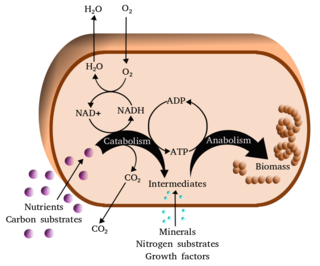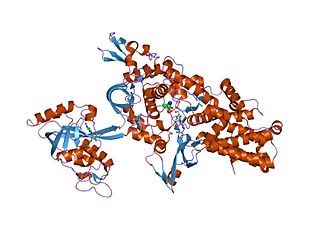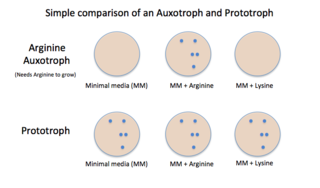Related Research Articles

The genetic code is the set of rules used by living cells to translate information encoded within genetic material into proteins. Translation is accomplished by the ribosome, which links proteinogenic amino acids in an order specified by messenger RNA (mRNA), using transfer RNA (tRNA) molecules to carry amino acids and to read the mRNA three nucleotides at a time. The genetic code is highly similar among all organisms and can be expressed in a simple table with 64 entries.

Metabolism is the set of life-sustaining chemical reactions in organisms. The three main functions of metabolism are: the conversion of the energy in food to energy available to run cellular processes; the conversion of food to building blocks for proteins, lipids, nucleic acids, and some carbohydrates; and the elimination of metabolic wastes. These enzyme-catalyzed reactions allow organisms to grow and reproduce, maintain their structures, and respond to their environments. The word metabolism can also refer to the sum of all chemical reactions that occur in living organisms, including digestion and the transportation of substances into and between different cells, in which case the above described set of reactions within the cells is called intermediary metabolism.

Proteins are large biomolecules and macromolecules that comprise one or more long chains of amino acid residues. Proteins perform a vast array of functions within organisms, including catalysing metabolic reactions, DNA replication, responding to stimuli, providing structure to cells and organisms, and transporting molecules from one location to another. Proteins differ from one another primarily in their sequence of amino acids, which is dictated by the nucleotide sequence of their genes, and which usually results in protein folding into a specific 3D structure that determines its activity.

Selenocysteine is the 21st proteinogenic amino acid. Selenoproteins contain selenocysteine residues. Selenocysteine is an analogue of the more common cysteine with selenium in place of the sulfur.

Pyrrolysine is an α-amino acid that is used in the biosynthesis of proteins in some methanogenic archaea and bacteria; it is not present in humans. It contains an α-amino group, a carboxylic acid group. Its pyrroline side-chain is similar to that of lysine in being basic and positively charged at neutral pH.

Coenzyme A (CoA, SHCoA, CoASH) is a coenzyme, notable for its role in the synthesis and oxidation of fatty acids, and the oxidation of pyruvate in the citric acid cycle. All genomes sequenced to date encode enzymes that use coenzyme A as a substrate, and around 4% of cellular enzymes use it (or a thioester) as a substrate. In humans, CoA biosynthesis requires cysteine, pantothenate (vitamin B5), and adenosine triphosphate (ATP).

Transfer RNA is an adaptor molecule composed of RNA, typically 76 to 90 nucleotides in length, that serves as the physical link between the mRNA and the amino acid sequence of proteins. tRNAs genes from Bacteria are typically shorter than tRNAs from Archaea and eukaryotes. The mature tRNA follows an opposite pattern with tRNAs from Bacteria being usually longer than tRNAs from Archaea, with eukaryotes exhibiting the shortest mature tRNAs. Transfer RNA (tRNA) does this by carrying an amino acid to the protein synthesizing machinery of a cell called the ribosome. Complementation of a 3-nucleotide codon in a messenger RNA (mRNA) by a 3-nucleotide anticodon of the tRNA results in protein synthesis based on the mRNA code. As such, tRNAs are a necessary component of translation, the biological synthesis of new proteins in accordance with the genetic code.

An aminoacyl-tRNA synthetase, also called tRNA-ligase, is an enzyme that attaches the appropriate amino acid onto its corresponding tRNA. It does so by catalyzing the transesterification of a specific cognate amino acid or its precursor to one of all its compatible cognate tRNAs to form an aminoacyl-tRNA. In humans, the 20 different types of aa-tRNA are made by the 20 different aminoacyl-tRNA synthetases, one for each amino acid of the genetic code.

Synthetic biology (SynBio) is a multidisciplinary field of science that focuses on living systems and organisms, and it applies engineering principles to develop new biological parts, devices, and systems or to redesign existing systems found in nature.

Auxotrophy is the inability of an organism to synthesize a particular organic compound required for its growth. An auxotroph is an organism that displays this characteristic; auxotrophic is the corresponding adjective. Auxotrophy is the opposite of prototrophy, which is characterized by the ability to synthesize all the compounds needed for growth.
Xenobiology (XB) is a subfield of synthetic biology, the study of synthesizing and manipulating biological devices and systems. The name "xenobiology" derives from the Greek word xenos, which means "stranger, alien". Xenobiology is a form of biology that is not (yet) familiar to science and is not found in nature. In practice, it describes novel biological systems and biochemistries that differ from the canonical DNA–RNA-20 amino acid system. For example, instead of DNA or RNA, XB explores nucleic acid analogues, termed xeno nucleic acid (XNA) as information carriers. It also focuses on an expanded genetic code and the incorporation of non-proteinogenic amino acids into proteins.
Chemical biology is a scientific discipline between the fields of chemistry and biology. The discipline involves the application of chemical techniques, analysis, and often small molecules produced through synthetic chemistry, to the study and manipulation of biological systems. In contrast to biochemistry, which involves the study of the chemistry of biomolecules and regulation of biochemical pathways within and between cells, chemical biology deals with chemistry applied to biology.

Directed evolution (DE) is a method used in protein engineering that mimics the process of natural selection to steer proteins or nucleic acids toward a user-defined goal. It consists of subjecting a gene to iterative rounds of mutagenesis, selection and amplification. It can be performed in vivo, or in vitro. Directed evolution is used both for protein engineering as an alternative to rationally designing modified proteins, as well as for experimental evolution studies of fundamental evolutionary principles in a controlled, laboratory environment.

Fatty acid synthase (FAS) is an enzyme that in humans is encoded by the FASN gene.

The acetolactate synthase (ALS) enzyme is a protein found in plants and micro-organisms. ALS catalyzes the first step in the synthesis of the branched-chain amino acids.
A cell-free system is an in vitro tool widely used to study biological reactions that happen within cells apart from a full cell system, thus reducing the complex interactions typically found when working in a whole cell. Subcellular fractions can be isolated by ultracentrifugation to provide molecular machinery that can be used in reactions in the absence of many of the other cellular components. Eukaryotic and prokaryotic cell internals have been used for creation of these simplified environments. These systems have enabled cell-free synthetic biology to emerge, providing control over what reaction is being examined, as well as its yield, and lessening the considerations otherwise invoked when working with more sensitive live cells.
Biomolecular engineering is the application of engineering principles and practices to the purposeful manipulation of molecules of biological origin. Biomolecular engineers integrate knowledge of biological processes with the core knowledge of chemical engineering in order to focus on molecular level solutions to issues and problems in the life sciences related to the environment, agriculture, energy, industry, food production, biotechnology and medicine.

Nucleic acid analogues are compounds which are analogous to naturally occurring RNA and DNA, used in medicine and in molecular biology research. Nucleic acids are chains of nucleotides, which are composed of three parts: a phosphate backbone, a pentose sugar, either ribose or deoxyribose, and one of four nucleobases. An analogue may have any of these altered. Typically the analogue nucleobases confer, among other things, different base pairing and base stacking properties. Examples include universal bases, which can pair with all four canonical bases, and phosphate-sugar backbone analogues such as PNA, which affect the properties of the chain . Nucleic acid analogues are also called Xeno Nucleic Acid and represent one of the main pillars of xenobiology, the design of new-to-nature forms of life based on alternative biochemistries.

An expanded genetic code is an artificially modified genetic code in which one or more specific codons have been re-allocated to encode an amino acid that is not among the 22 common naturally-encoded proteinogenic amino acids.

An organism is any biological living system that functions as an individual life form. All organisms are composed of cells. The idea of organism is based on the concept of minimal functional unit of life. Three traits have been proposed to play the main role in qualification as an organism:
References
- ↑ "Scripps Research Institute Names Peter Schultz as CEO, Steve Kay as President".
- ↑ "Xconomy: Peter Schultz Exits Top Job at Genomics Institute of the Novartis Research Foundation". 2010-07-14.
- ↑ Huggett, Brady; Paisner, Kathryn (7 August 2014). "Top 20 translational researchers in 2013". Nature Biotechnology. 32 (8): 720. doi: 10.1038/nbt.2986 . PMID 25101739.
- 1 2 "Carl Shipp Marvel Lecturer 2008-09 - Peter G. Schultz | Chemistry at Illinois".
- ↑ "calibr | California Institute for Biomedical Research>". Archived from the original on 2012-03-19.
- ↑ "Merck to create institute, hire 150 in la Jolla". 2012-03-15.
- ↑ "Merck's New Model for Collaboration". Chemical & Engineering News.
- ↑ Service, R. F. (15 March 2012). "New Institute Aims to Help Academics Make Medicines". Science. 335 (6074): 1288–1289. Bibcode:2012Sci...335.1288S. doi:10.1126/science.335.6074.1288. PMID 22422951.
- 1 2 Curriculum Vitae Archived 2008-03-28 at the Wayback Machine
- ↑ Lyssiotis, Costas A.; Foreman, Ruth K.; Staerk, Judith; Garcia, Michael; Mathur, Divya; Markoulaki, Styliani; Hanna, Jacob; Lairson, Luke L.; Charette, Bradley D.; Bouchez, Laure C.; Bollong, Michael; Kunick, Conrad; Brinker, Achim; Cho, Charles Y.; Schultz, Peter G.; Jaenisch, Rudolf (2 June 2009). "Reprogramming of murine fibroblasts to induced pluripotent stem cells with chemical complementation of Klf4". Proceedings of the National Academy of Sciences of the United States of America. 106 (22): 8912–8917. Bibcode:2009PNAS..106.8912L. doi: 10.1073/pnas.0903860106 . PMC 2690053 . PMID 19447925.
- ↑ "The Peter G. Schultz Laboratory". Archived from the original on 2010-05-23.
- ↑ Mehl, Ryan A.; Anderson, J. Christopher; Santoro, Stephen W.; Wang, Lei; Martin, Andrew B.; King, David S.; Horn, David M.; Schultz, Peter G. (January 2003). "Generation of a Bacterium with a 21 Amino Acid Genetic Code". Journal of the American Chemical Society. 125 (4): 935–939. doi:10.1021/ja0284153. PMID 12537491.
- ↑ "Context :: 21-amino-acid bacteria: Expanding the genetic code".
- ↑ "Research".
- ↑ Mehta, Angad P.; Wang, Yiyang; Reed, Sean A.; Supekova, Lubica; Javahishvili, Tsotne; Chaput, John C.; Schultz, Peter G. (30 August 2018). "Bacterial Genome Containing Chimeric DNA–RNA Sequences". Journal of the American Chemical Society. 140 (36): 11464–11473. doi:10.1021/jacs.8b07046. PMID 30160955. S2CID 52132524.
- ↑ Martin, William F.; Mentel, Marek (2010). "The Origin of Mitochondria". Nature Education. 3 (9): 58.
- ↑ Mehta, Angad P.; Supekova, Lubica; Chen, Jian-Hua; Pestonjamasp, Kersi; Webster, Paul; Ko, Yeonjin; Henderson, Scott C.; McDermott, Gerry; Supek, Frantisek; Schultz, Peter G. (13 November 2018). "Engineering yeast endosymbionts as a step toward the evolution of mitochondria". Proceedings of the National Academy of Sciences. 115 (46): 11796–11801. doi: 10.1073/pnas.1813143115 . PMC 6243291 . PMID 30373839.
- ↑ Mehta, Angad P.; Ko, Yeonjin; Supekova, Lubica; Pestonjamasp, Kersi; Li, Jack; Schultz, Peter G. (16 August 2019). "Toward a Synthetic Yeast Endosymbiont with a Minimal Genome". Journal of the American Chemical Society. 141 (35): 13799–13802. doi:10.1021/jacs.9b08290. PMC 6999831 . PMID 31419116.
- ↑ Service, Robert F. (2009). "A Dark Tale behind Two Retractions". Science. 326 (5960): 1610–1611. Bibcode:2009Sci...326.1610S. doi:10.1126/science.326.5960.1610. JSTOR 27736671. PMID 20019260.
- ↑ "Peter Schultz wins Tetrahedron Prize for Creativity in Organic Chemistry".
- ↑ "Yale awards nine honorary degrees at Commencement 2015". 2015-05-15.
- ↑ "Peter Schultz to Receive Solvay Prize | Chemical & Engineering News".
- ↑ "Honorary doctorates - Uppsala University, Sweden".